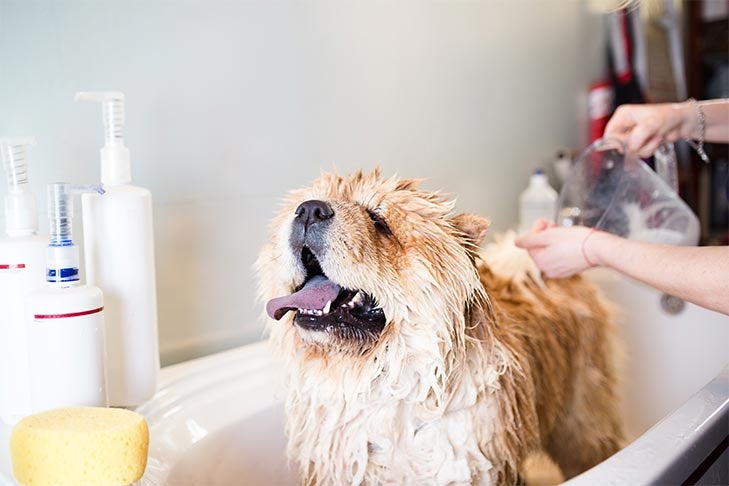|
Many dog owners can recall a certain dreaded scenario. You’re sitting around your living room with a few guests when suddenly, your dog starts scooting their bottom brazenly across the floor in front of everyone.
In reality, scooting is a dog’s way of trying to alleviate something wrong back there. That might mean an itch, irritation, pain, or other problem that ranges from the mildly uncomfortable to the medically concerning. Educating yourself on the causes of scooting problems will help lead to more direct resolutions.
Clogged Anal Sacs
Dogs have two small anal sacs on either side of their rear end that contain a foul, fishy-smelling liquid they release when they poop. The liquid may be a biomarker that helps leave a sort of “poop print” for other dogs to smell.
Normally, your dog’s bowel movement triggers their anal sacs to empty. But if they’re not working properly, the fluid can build up. The glands in the sacs have a tendency to get inflamed, solidifying the liquid and hindering its release. When the sacs are continuously full or not emptying properly, it can be painful and this area may even become infected.
Resolution
Visit your veterinarian if the problem seems serious. Antibiotic ointment and warm compresses may also be recommended.
“If your dog’s glands look very enlarged or they’re having bloody discharge, it’s time to see your vet,” says Dr. Sara Ochoa, DVM. “If the anal glands are very full, we express them. When they are infected, dogs get a round of antibiotics and sometimes pain medication.”
Skin Irritation From Grooming
Dogs that get groomed frequently, such as Cocker Spaniels and Poodles, may experience clipper burns and irritations from sprays, perfumes, or grooming products that get under their tail and around their bottom.
Resolution
Check for tiny nicks and razor burn if your dog scoots after grooming. If they’re itching all over (including rolling around on their back), it may be due to a grooming product. Ask the groomer to switch products, or bring in your own oatmeal-based, sensitive-skin, hypoallergenic, or organic bath products and dog shampoos. A warm compress is another option to help alleviate irritation due to grooming.

Food Allergies
Food allergies or intolerances may be to blame for some dogs’ anal sac issues. If soft or watery bowel movements aren’t providing the pressure needed to empty the sacs properly, diet may be the cause. A diet with only one or two types of protein, not enough fiber, or one that contains grains like corn, oatmeal, rice, wheat, or soy can be what’s affecting stools and preventing the anal sacs from functioning properly.
Resolution
Talk to your veterinarian about making dietary changes. “I frequently recommend adding canned pumpkin to their diets. Or using Glandex, a product that helps decrease anal gland material and helps the glands express easier,” says Ochoa.
Trauma to Anal Sacs
Your dog may have experienced trauma to their anal sacs by a groomer who manually expressed the glands unnecessarily. But, these sacs are delicate and can be injured by manipulation or squeezing during manual expression. The glands can experience tissue damage and become inflamed, preventing them from functioning normally. Repeated expressing can injure your dog’s anal sacs. What’s more, the sacs can lose the necessary muscle tone that enables them to express themselves on their own.
Resolution
In the past, groomers were taught to express anal sacs as part and parcel of your dog’s grooming services. However, dogs rarely needed this service as their anal sacs were designed to function just fine on their own.

That said, groomers should be encouraged to check to see if the anal sacks are full and if so, to gently empty them. Many times, groomers are the first line of alert of growths and other issues, so it’s best to allow them to check first, and empty if needed.
Intestinal Parasites
Intestinal parasites, like tapeworms, could be another culprit for your dog’s scoots. Dogs can get tapeworms by ingesting a flea carrying immature tapeworm larvae. These can cause itching and irritation around the anus when the tapeworms exit after maturing in the stomach. Telltale signs of tapeworms include an itchy bottom, scooting, and rice-like segments of worms around the anus, in your dog’s feces or their bedding.
Resolution
Visit your vet for an examination right away if you suspect parasites.
“Even if you don’t see worms, they still may be there,” says Ochoa. “Your veterinarian can check a fecal flotation and see if your dog has worms. These are easily treated by a dewormer.”

The bottom line is, if your pup scoots once or twice, it may just be an itch or dirty bottom after a trip outside. But if you notice scooting behavior more frequently, constant licking and biting of the rear area, or other signs of swelling or abnormality, take your pup to the vet right away for an exam to get to the root of the scooting.
The post Why Is My Dog Scooting? appeared first on American Kennel Club.



0 Comments
Recommended Comments
There are no comments to display.